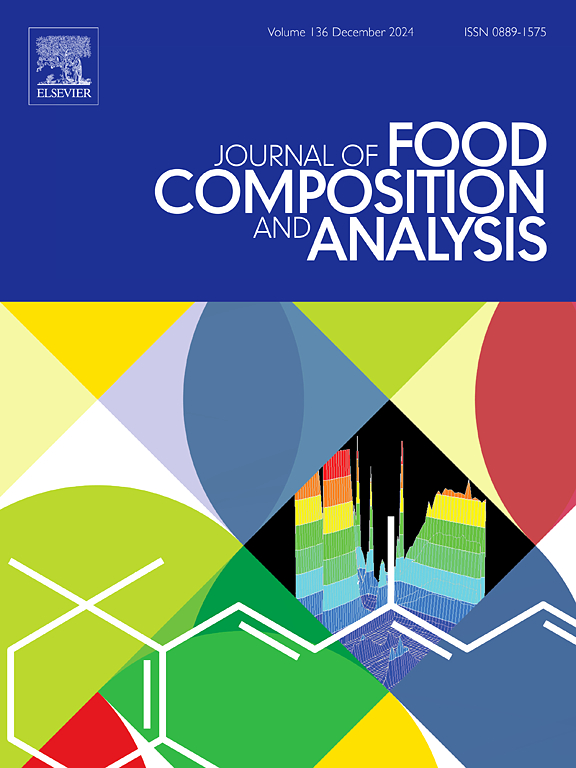自来水中无机硒形态的分析方法:高效液相色谱-连续流氢化物生成-原子吸收光谱法
IF 4.6
2区 农林科学
Q2 CHEMISTRY, APPLIED
引用次数: 0
摘要
无机硒的形成是一个重要的课题,因为亚硒酸盐(Se(IV))和硒酸盐(Se(VI))具有不同的毒性和生物利用度。为此,提出了高效液相色谱-连续流氢化物生成(含在线预还原过程)-火焰原子吸收光谱法(HPLC-CFHG-FAAS)对自来水样品中无机硒进行形态分析。对HPLC和CFHG系统的参数进行了综合优化,以获得足够的峰分辨率和高信噪比。然后,对HPLC-CFHG-FAAS体系分析硒(IV)和硒(VI)的优值进行了分析。硒(IV)和硒(VI)的检出限(LOD)/定量限(LOQ)分别为0.09/0.31 mg/kg(以Se计)和0.23/0.77 mg/kg(以Se计)。采用矩阵匹配校准(MMC)策略,计算出Se(IV)和Se(VI)的可接受回收率分别为72.0 % ~ 101.5 %和104.0 % ~ 115.9 %。结果表明,该方法可用于自来水样品中无机硒的形态分析。本文章由计算机程序翻译,如有差异,请以英文原文为准。
An analytical approach for inorganic selenium speciation in tap water samples: HPLC – continuous flow hydride generation – FAAS
Inorganic selenium speciation is a crucial topic since selenite (Se(IV)) and selenate (Se(VI)) have different toxicity and bioavailability. Therefore, a high performance liquid chromatography-continuous flow hydride generation (containing an online pre-reduction process)-flame atomic absorption spectrometry (HPLC-CFHG-FAAS) was proposed to carry out inorganic selenium speciation in tap water samples. Parameters of HPLC and CFHG systems were comprehensively optimized to obtain sufficient peak resolution and high signal to noise ratio. After, analytical figures of merit of the HPLC-CFHG-FAAS system for Se(IV) and Se(VI) were examined. Limit of detection (LOD)/limit of quantitation (LOQ) for Se(IV) and Se(VI) were recorded as 0.09/0.31 mg/kg (as Se) and 0.23/0.77 mg/kg (as Se), respectively. Acceptable recovery results were calculated in the range of 72.0 %-101.5 % and 104.0 %-115.9 % via matrix matching calibration (MMC) strategy for Se (IV) and Se(VI), respectively. The obtained recovery results presented that the proposed method can be applied for the speciation of inorganic selenium in tap water samples.
求助全文
通过发布文献求助,成功后即可免费获取论文全文。
去求助
来源期刊

Journal of Food Composition and Analysis
工程技术-食品科技
CiteScore
6.20
自引率
11.60%
发文量
601
审稿时长
53 days
期刊介绍:
The Journal of Food Composition and Analysis publishes manuscripts on scientific aspects of data on the chemical composition of human foods, with particular emphasis on actual data on composition of foods; analytical methods; studies on the manipulation, storage, distribution and use of food composition data; and studies on the statistics, use and distribution of such data and data systems. The Journal''s basis is nutrient composition, with increasing emphasis on bioactive non-nutrient and anti-nutrient components. Papers must provide sufficient description of the food samples, analytical methods, quality control procedures and statistical treatments of the data to permit the end users of the food composition data to evaluate the appropriateness of such data in their projects.
The Journal does not publish papers on: microbiological compounds; sensory quality; aromatics/volatiles in food and wine; essential oils; organoleptic characteristics of food; physical properties; or clinical papers and pharmacology-related papers.
 求助内容:
求助内容: 应助结果提醒方式:
应助结果提醒方式:


